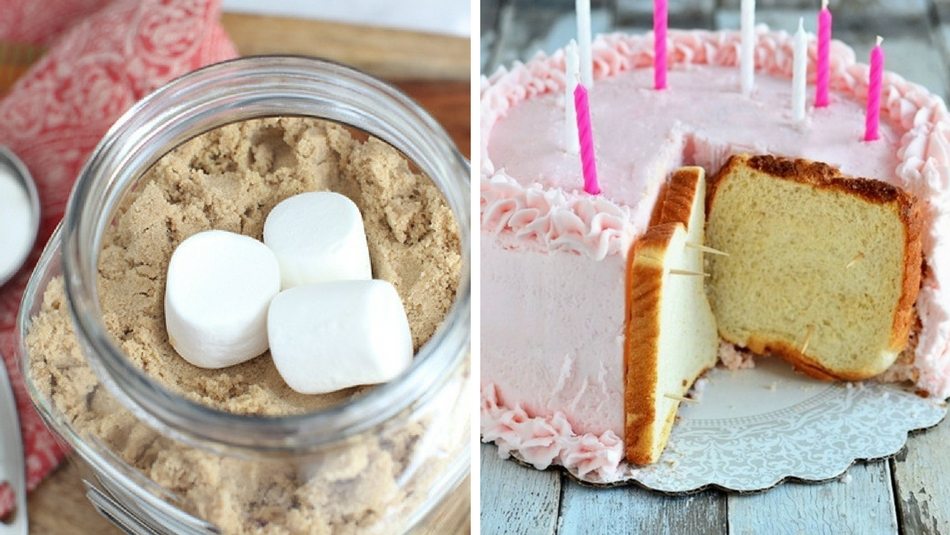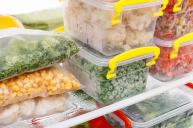Sometimes I get really excited when I go to the grocery store. That and the combination of shopping while hungry leads to me piling my cart with food. Once at home I put everything away in its place, promising to eat every single thing I bought ASAP. Days begin to go by and it's become apparent that buying that gigantic tub of spinach probably wasn't the best decision as it looks like it is on it's last leg.
Videos by Wide Open Country
Ashamed that I couldn't eat an entire package of spinach on my own, I was forced to discard it along with the money I spent on it. Thankfully I've come across some amazing (and totally genius) food storage tips to make sure your food stays fresh for all your tasty recipes.
1. Store brown sugar with a marshmallow.
More times than not, I've opened up my bag of brown sugar and been greeted with a hunk reminiscent of a lump of coal. To assure that your brown sugar will be soft for your oatmeal or your chocolate chip cookies follow this tip from Greg at 7th House on the Left.
Brown sugar, which is coated in molasses, tends to lose moisture over time and sticks together. To counteract this Greg adds a few marshmallows to his storage container of brown sugar to add moisture. When one of the marshmallows becomes hard he just switches it out for a new one. Genius!
2. Wrap celery in aluminum foil.
Crisp celery, good. Soggy celery, really bad. To guarantee your celery keeps its bite use this trick by Courtnay at Creekline House. Once you have brought your celery home from the store wrap the end (or even the entire celery) with aluminum foil. Once wrapped place it in the fridge.
She claims that after a few weeks the celery was as crisp as ever. Peanut butter anyone?
3. Wrap fresh herbs in a damp paper towel.
The Pioneer Woman has done it again with this nifty herb trick. Unless you use fresh herbs in every recipe you make, there always seems to be leftover herbs sitting in the fridge getting totally soggy or dried out.
To prevent this simply wrap the hearty herbs (like thyme, rosemary) in a damp paper towel placed in a ziploc bag. The herbs stored this way can last around two weeks, making this a super simple and helpful tip.
4. Freeze leftover chicken stock.
There's more times then I like to count that I've thrown out half-used cartons of chicken stock because they've sat in the fridge too long. However Lindsey over at American Heritage Cooking, a blog that focuses on heritage and heirloom recipes, has a tip to prolong the shelf life of your cooking stocks.
Once you have opened up that carton of chicken stock (or made your own) pour the remaining stock into muffin tins and place them in the freezer. Once frozen pop the stock out of the muffin tins and place in a freezer bag. Not only is the cooking stock pre-portioned, it's good to go whenever you need a touch of stock.
5. Store nut butter upside-down.
Of all the food storage ideas, this one takes the cake. I mean, it's so simple I'm on the verge of hitting myself on the forehead for not thinking of this before. Gwen from The Bold Abode swears by this one trick to keep her natural peanut butter from separating.
Take your jar of peanut butter and flip it over. Place in the cabinet. Done. Next time you have a hankering for peanut butter the oil will be easier to stir in making you that much closer to your peanut butter dreams.
6. Store bananas separately.
While brown bananas make delicious banana bread (and banana pancakes) it's always better in my opinion to eat firm bananas than mush and squishy. And Emily Leaman from PhillyMag agrees whole-heartedly.
According to her, bananas emit ethylene through their stems which then ripen the rest of the skin of the banana. By simply wrapping the stem with plastic wrap her bananas lasted eight days before it started to turn. Not bad if I say so myself.
7. Bathe berries in a vinegar bath.
I need this in my life. I don't know how my berries do it, but within 24 hours they always start to go bad. I feel like it's always race to eat an entire carton before that first hit of mold pops up.
Kristin from Live Simply has the genius solution of soaking her berries in a solution of vinegar and water to prevent mold from growing. After soaking the berries for five minutes, she removes, dries them and stores the berries in a container with paper towels.
8. Freeze cut green onions.
Riddle me this: green onions come in bunches however most recipes call for one to two green onions. So what do I do with the rest? One Crazy House has come up with a genius solution and it's brilliant.
When you buy green onions chop them all up then place them in a clean container (they use an old Parmesan cheese container) and stick it in the freezer. Just pop them out of the freezer and sprinkle whenever needed.
9. Keep lettuce fresh with a paper towel.
I love eating salads but there's only so much salad one girl can handle. Nicole from Pinch My Salt (yes we love the name too) has come up with a fun idea to keep salad greens fresh and crisp. The key: a salad spinner.
Nicole first fills her kitchen sink with cold water, adds the lettuce (making sure to separate all of the leaves), then swirls the water. Once the lettuce has washed, she transfers it to a salad spinner to dry. Next she places the dried lettuce on paper towels and wraps the towels around the lettuce before sliding it into a gallon-size zip baggie. She swears her lettuce stays crisp for a couple of weeks.
10. Store onions, garlic and potatoes in perforated bags.
Monica from The Yummy Life was astonished at how her Mom stored onions and garlic for months at a time. No fancy onion or garlic gadget here, just a few paper bags punched with a hole puncher and a paper clip to keep everything neat and tidy.
Why does this work? Root vegetables like onions and garlic love dark, dry and cool places. The bags keep the vegetables covered and the perforated bags allow air to circulate. She also stores the vegetables in a cupboard which keeps the vegetables completely in the dark when not in use.
11. Prevent ice cream freezer burn with wax paper.
There's nothing worse that opening up your carton of ice cream and finding big shards of ice. And even after pick-axing your way through the ice, the ice cream itself has lost all of its flavor.
Welcome While Wearing Heels and her brilliant idea- placing a piece of wax paper on the ice cream to prevent freezer burn. It totally works, whatever the ice cream.
12. Store cookies with a slice of bread.
Just like the hack that uses a marshmallow to add moisture to brown sugar, The Seaside Baker places a piece of white bread in her bag of cookies to keep the moisture locked in.
When the bread is as hard as a rock replace it with a fresh piece and nibble away at your cookies.
13. Freeze leftover tomato paste.
This kitchen storage hack just makes so much sense! Beth from Budget Bytes has been freezing her leftover tomato paste for ages. She says it is always nice to have some on hand whenever she cooks on a whim.
When opening a new can of tomato paste she takes 1 tablespoon dollops of the paste and places it on a piece of plastic wrap on a plate. Then after a quick freeze in the freezer, she transfers the pre-portioned tomato paste to a freezer bag for long-term storage.
14. Keep cakes moist with a slice of bread.
Have you ever made a cake, eaten some of it, then the next day come back to get a slice and the outside edge is totally stale? And even through you still ate it (or is it just me?), a stale cake is never as good as fresh.
Combat stale cake with this helpful tip from Shareably. Using toothpicks, place a piece of bread on the exposed part of the cake and place it into the fridge. The next day the bread will be stale and the cake still perfectly moist. Don't mind me as I take another slice.
15. Freeze herbs in olive oil.
I love growing herbs in my garden (not that it's the only plants that survive or anything) but it's hard to use every single herb before the plant starts to go. To counteract this Beth from Tasty Yummies freezes her fresh herbs in olive oil.
First she fills an ice cube tray with fresh herbs like rosemary, sage and thyme. Then she adds a healthy glug of olive oil to the trays and freezes. Once the cubes are frozen she removes them from the trays and places them in plastic bags to keep them in the freezer until needed.


















